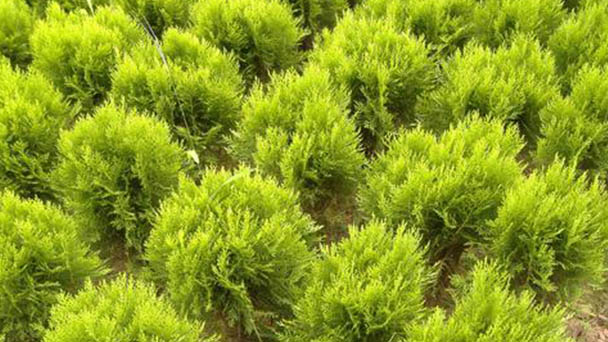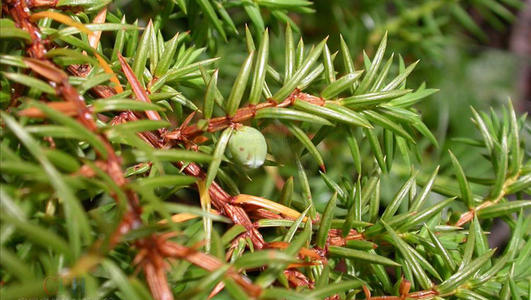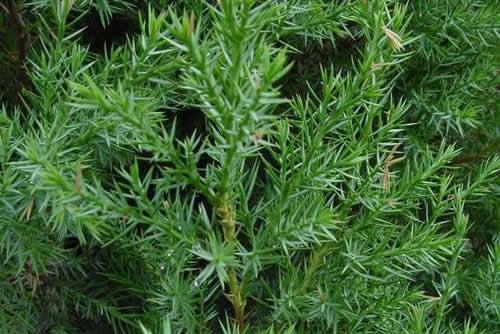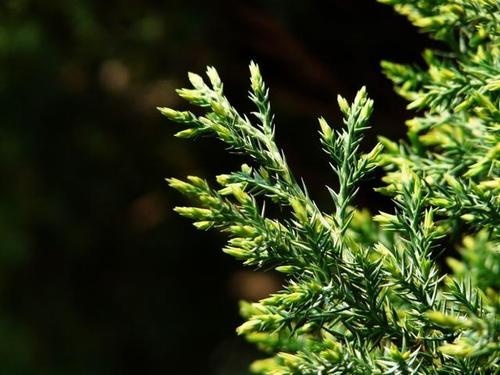Juniperus formosana (Formosan juniper) profile
Written by Maggie
Nov 13 2021

Juniperus Formosana, also called Formosan juniper, is an evergreen small tree, like cold climate, strong cold resistance, the soil requirements are not strict, acid soil and the seaside in the dry rock between the cracks and gravel can grow. Juniperus Formosana is light - loving, cold - resistant, drought - resistant, main lateral roots are very developed, in the dry sand, sunny slopes and rock crevices can grow, as the best decorative stone garden tree species. Juniperus Formosana is commonly used for garden purposes, widely used in highway greening.
Juniperus formosana picture

Morphological characteristics of Juniperus formosana
Juniperus Formosana is up to 12 m high; Bark is brown, longitudinal slit strip off; Branches are oblique or straight, tower - shaped or cylindrical crown; Branchlets are pendulous, triangulate. Leaves of juniperus formosana are 3 leaf whorl, strip lanceolate or strip shape, 1.2 2 cm long, rarely up to 3.2 cm, 1.2 2 mm wide, apex acuminate with sharp pointed, the above slightly concave, midrib slightly uplift, green, on each side has one white, rarely purple or light green stomatal band, porosity belt is slightly wide, green sideband in leaf apex fused into 1, the following green, glossy, with longitudinal blunt ridge, a transverse crescent. Male globose or elliptic, 4-6 mm long, septum apex acuminate, dorsal ridged.
Cones of Juniperus Formosana are subglobose or broadly ovoid, 7-10 mm long, 6-9 mm in diameter, two years of maturity, reddish brown when ripe, by white powder or white powder shed, apical with 3 radial wrinkles and 3 blunt head, occasionally tip micro dehiscent; Juniperus Formosana has 3 seeds, 1 sparse, semiluncular, with 3-4 ridges, apical acuminate, with 3-4 resin slots near the base.
Read More:
12 Wonderful Evergreen Shrubs for Your Garden
Ecological habits of Juniperus formosana
Juniperus Formosana is light - loving, cold - tolerant, drought - tolerant, main lateral roots are very developed, in the dry sand, in the fertile permeability of the best growth soil. Sunny hillside and rock crevices can grow, as the best decorative stone garden tree species. In nature, Juniperus Formosana is often scattered in the elevation of 1300~3400 meters, but not a large forest.
The distribution area of Juniperus formosana
Juniperus Formosana is China's endemic tree species, from temperate to cold zone distribution, Taiwan Province, China. The main breeding bases are Jiangsu, Zhejiang, Anhui, Hunan, Henan and other places. Juniperus Formosana is found in mountains below 500 m in heilongjiang, jilin and Liaoning. and 1400 m in wula mountain of nei Mongolia, as well as high mountains 1400 ~ 2200 m in Xiao wutai mountain and huashan mountain of hebei province. Juniperus Formosana is distributed from temperate zone to frigid zone and also in Taiwan province of China.Yiyi, Li and Taihu Lake along the hills; Nanjing, Shanghai and other places in the garden cultivation; Distribution in the south of the Yangtze River provinces. Produced in Taiwan, Jiangsu, Anhui, Zhejiang, Fujian, Jiangxi, Hubei, Hunan, Shaanxi, Gansu, Qinghai, Sichuan, Guizhou, Yunnan, Xizang and other high mountain areas, often appear on limestone or calcareous soil.
Juniperus formosana growing methods
Seedling site selection
Seedling land for Juniperus Formosana should be flat, leeward to the sun, convenient transportation, drainage and irrigation conditions of the plot.
Preparation before seedling raising
1. Seedbed finishing
Combined with deep digging of the soil, remove weeds, stones and other debris in the ground; According to the net width of the nursery bed about 1.2m to do a low bed, length according to the terrain, furrow bottom width 40cm, 30cm, 25cm high, ramming, flat, can also be directly paved with bricks bedding furrow (about 4~5 layers of brick). The bed surface for Juniperus Formosana should be smooth and flat to facilitate the placement of containers and bags.
2. Container bag selection
The container bag is made of polyethylene film with a diameter of 10cm and a height of 15cm. The wall of the bag is made of 10 holes with a diameter of 2~3mm, which is easy to permeate to water and air.
3. Nutrient soil preparation
Because Juniperus formosana does not require very high soil quality of the seedling site, it is possible to obtain the nutrient soil for container seedlings by following the principle of "adapting measures to local conditions and using local materials" by pulling the fully matured loess nearby or using the original soil of the seedling site through disinfection, fertilization and other measures. Humus soil in the forest has the best effect.Specific methods are as follows:
Nutrient soil preparation, soil disinfection and fertilization are carried out simultaneously. In line with "loose structure, water moisture, permeability good, rich in nutrients," the principle of loess with 0.1 m3 per m3 sand, farmyard manure, 500 kg, 25 kg calcium superphosphate, ammonium dihydrogen phosphate 5 kg, the proportion of mixed with phosphorus 150 g, play, the cotton, turn the soil, then sieve, sieve while using atomizer spraying 0.5% of ferrous sulfate soil disinfection. Use the humus soil inside the forest to make up, but need not or less use farmhouse manure.
4. After the nutrient soil is filled with the container bag, the nutrient soil is loaded into the container bag. When the soil is filled, it should be filled with solid. Then, the container bags of nutrient soil are placed close to each other in the seedbed, in neat, symmetrical arrangement. In order to reduce the gap between the containers and bags, each row of 5~6 rows, in the new row of container bags pad the length of 0.8~1.0m, about 15cm wide board, with a hammer gently vibrating. When the seedbed is full, fill all the Spaces between the container bags with fine soil to reduce evaporation and prevent the container bags from tipping over after watering.

Cutting seedlings
1. Cutting collection and processing
Choose healthy Juniperus Formosana with good growth and no pests and diseases at about 10a as the mother trees for ear picking. Fully exposed, well-developed 1 to 2-year old robust hard branches with a stem diameter of about 1cm were collected from the upper and peripheral parts of the mother tree as cuttings. The cuttings were cut from the middle and upper parts of the cuttings, the spikes were about 25cm long, the leaves in the middle and lower parts were cut (about 10cm), and the cuttings were cut into horseshoe-shaped incisions under the cuttings. Each 100 roots were bundled into bundles and soaked in ABT1 root powder solution with the concentration of 50mg·kg-1 for 2~3h.
2. Cutting time and method
Juniperus formosana hard branch cuttings container seedling used with picking, cutting, dipping, with the method of insertion. Autumn cuttings, the use of wet interpolation method, that is, first in the seedbed irrigation, after the water infiltration, will be processed cuttings directly into the container bag, each bag a cutting depth of about 10cm; When the seedbed is full, water is poured again to make the soil close to the cuttings. Then, cover the bed surface with about 2cm of vegetation ash or sawdust, in order to keep wet and heat preservation, and prevent soil hardening. Spring cuttings, using the same methods as in autumn. Autumn cuttage, can build a small bow shed on the seedbed, conducive to moisturizing, heat preservation, and promoting rooting.
Seedling stage management
Hard cuttings of Juniperus formosana can only take root about 2 months after cuttings, and there are few pests and diseases. Therefore, seedling management is mainly based on irrigation, weeding and fertilization.
Water
Because of Juniperus Formosana's long rooting time, it often keeps the bed surface moist. Spring cuttings, in about 20 days after the insertion of a permeable irrigation, after depending on the dry and wet situation of the seedbed watering;Autumn cuttings, spring next year after pouring a permeable, after depending on soil moisture.
Weeding
We should promptly organize labor to remove weeds seedbed, avoid grass, seedlings for fertilizer for water.
Fertilization
Fertilization was carried out in two ways. Foliar spraying with 0.5% potassium dihydrogen phosphate was carried out in the middle of each month. Nitrogen fertilizer (urea or diammonium) was applied twice in combination with irrigation, and the dosage was 0.5kg per 10,000 bags. Attention should be paid to rinse foliar fertilizer with clean water in time to prevent seedling burning. At the same time, attention should be paid to the observation of seedling growth, timely development of pest control.
Disease control of Juniperus formosana
Because the environment humidity of Juniperus formosana cuttages is too large, it will cause cuttages black stem disease, aphids and other common diseases and insect pests of Juniperus formosana, so in the early stage of seedling must be sprayed once a week with chlorothalonil, carbendazim, oxycyanide, potassium permanganate and other bactericidal agents.
Garden use of Juniperus Formosana
Juniperus formosana is one of the preferred tree species in urban and rural greening and new rural construction because of its beautiful tree shape, cold and drought resistance, strong resistance to stress, green leaves, evergreen in winter and summer, red and brown or blue and black fruit, and good performance in air purification, improving urban microclimate and reducing noise. Juniperus Formosana is the most common plant in urban greening. Juniperus Formosana can match planting, cluster planting, belt planting.Juniperus formosana has strong endurance to dirty air. Juniperus Formosana is planted in the center of urban streets and along the road. Juniperus Formosana grows well, does not hinder the sight, absorbs dust and purifies the air. Summer green Holly, do not block the light, do not hinder the vision, especially in the snow with more vitality. Juniperus formosana is planted on lawns, flower beds, rocks and under forests, which can increase the greening level and enrich the aesthetic feeling of viewing.
Juniperus formosana is an excellent tree species for landscaping. Juniperus Formosana has a beautiful tree shape and can be planted alone and arranged to form a special landscape. Juniperus Formosana can be used in northern gardens. Juniperus Formosana is one of the good coastal garden trees. Juniperus Formosana is also a good material for making bonsai. The tree is graceful, the twigs are thin and drooping; The trunk is vigorous, the needles are fine and green; The reddish-brown or orange-brown cones are persistent.

Latest Updated
- Benefits of Bugleweed - 7 Science-backed Health Benefits
- Bugleweed Dangers & Side Effects - Is It Poisonous?
- How to Plant Evergreen Trees - What You Should Know
- When to Plant Evergreens - Grow Guide for Evergreen Trees
- 12 Wonderful Evergreen Shrubs for Your Garden
- 12 Popular Evergreen Plants with Pictures for Beginners
- When And How To Prune A Lilac Bush Like a Pro
- How to Grow & Care for Lilac Vine (Hardenbergia Violacea)
- Japanese Lilac Tree (Syringa Reticulata) Care & Propagation Guide
- Shumard Oak Pros and Cons - What to Know
Popular Articles
- Winter maintenance of Antirrhinum Majus
- How to Grow Terminalia Mantaly Tree
- How to Grow and Care for Crossostephium Chinense
- How to grow Antirrhinum Majus in spring
- Peristeria Elata (Dove Orchid) Profile: Info & Care Guide
- Underwatered Snake Plant (Sansevieria Trifasciata) - Signs And How To Fix
- How to Care for Brazilian Jasmine Plant (Mandevilla Sanderi)
- How to Grow & Care for Graptopetalum Purple Delight in Summer
- Rosa Chinensis (China Rose): Plant Growing & Care Tips
- How to Care for Baby Sun Rose (Aptenia Cordifolia)